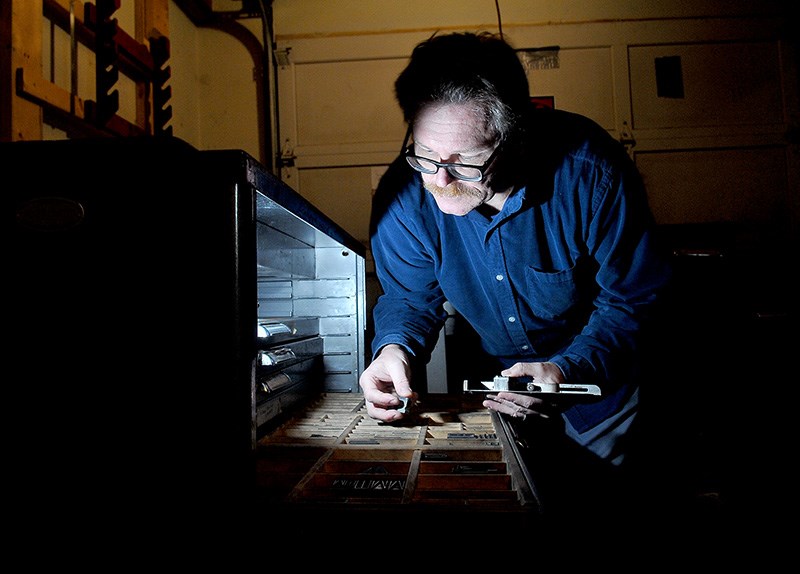These words you’re reading were crafted by the reporter then turned into digital zeros and ones before being printed on paper or uploaded to the internet.
Not so many years ago, the craft of printing words on paper was a much more involved, laborious task that involved dozens of skilled journeymen and tons of heavy machinery.
Each word, paragraph and story committed by the writer to paper had to be assembled into frames with cast lead dies, letter-by-letter, punctation mark-by-punctuation mark.
Those heavy frames, or chases, were then placed into large presses where rollers inked the raised metal letters and then pressed paper to them to create a printed page.
But like so many arduous processes borne of the Industrial Age, manual typesetting and printing is becoming a craft lost to the speed, efficiency and cleanliness offered by computers.
“There is a problem when we go too fast,” said Markus Fahrner a Port Moody graphic artist who’s also the coordinator at the city’s Station Museum.
So, in an effort to slow the process of printing down and reconnect with the skills he first learned as a boy growing up in Germany where his mother was a book designer, Fahrner acquired a Colt Armoury press that was likely built by the gun manufacturer in 1914.
But this is no ordinary old press.
It was once owned and carefully maintained in working order by Jim Rimmer, a world-renowned typographer and letterpress printer who kept the old-world craft alive from a studio behind his New Westminster home until he died in 2010.
The stained glass lit studio and Rimmer’s basement were crammed with old letterpresses, typesetters and spare parts salvaged from print shops that had moved on in technology. He restored the machines and designed dozens of typefaces in metal for printing limited edition books, posters and one-sheets that were coveted by collectors around the world.
Shortly after his death, he was awarded the Robert R. Reid award for lifetime achievement or extraordinary contributions to the book arts in Canada by the Alcuin Society, a volunteer society dedicated to the artistic side of printing books.
Fahrner said he couldn’t believe the good fortune of his find.
While much of Rimmer’s printed works, printers’ dummies, manuscripts and type design work was acquired by the Simon Fraser University library after his passing, the fate of his collection of heavy machinery was less certain.
Fahrner said it’s important to keep the old machines running rather than have them end up as decorative curios in restaurants or antique shops.
“I really admire the craft,” Fahrner said. “I love the way it forces you to slow down.”
In fact, a poster that might take Fahrner a couple of hours to design on a computer can take days to assemble and print on the letterpress.
“It’s slow and precise,” he said. "You suddenly have so much to know about the process, like the way the ambient temperature of the room affects the ink, the type of paper you’re using, how heavy an impression you want to make on the paper.”
The end product, Fahrner said, has a depth and life that can’t be produced digitally.
“There’s an intrinsic love and energy in the things you produce,” he said.
And an eternal connection to a craft whose purpose hasn’t changed since Johannes Gutenberg invented the printing press in the 15th century, even as its technology evolves.



